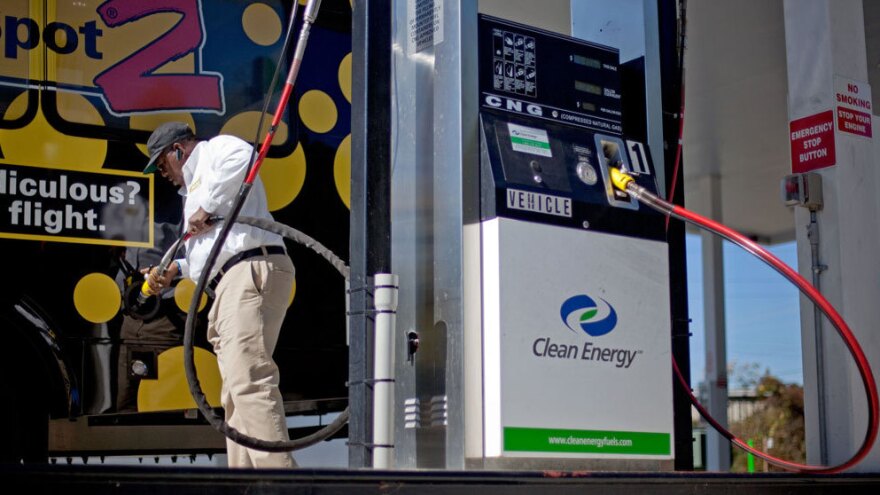Interest in natural gas vehicles soared in the 1990s and then faded. Twenty years later, the cost of gasoline is going up while the cost of natural gas is going down. And that difference in price explains the resurgent interest in natural gas vehicles.
In Indiana, Fair Oaks Dairy Farm does more than just produce milk — it is also in the transportation business. The farm owns 60 trucks, which deliver milk to a processor halfway across the state. Last September, most of the trucks were converted to natural gas.
"It's great," says Joel Romein, one of the drivers. "It's going to change the economy on how we use natural gas and how we fuel our trucks.
How much different is it to fuel it with natural gas as opposed to diesel?
"It's a lot cleaner — I don't get messy hands," Romein answers with a laugh.
The dairy is in step with larger companies like AT&T and UPS, which have recently added natural gas to their trucking fleets.
Twenty years ago, the federal incentives and high gas prices led fleet managers to retrofit thousands of light trucks and city buses to use compressed natural gas as fuel. But, that boom didn't last.
Rich Kolodziej, president of NGVAmerica, a trade association that lobbies for the use of natural gas in vehicles, says there hasn't been this much interest since the early 1990s, when stations popped up across the country.
"There was enthusiasm. Even Amoco started building public stations. They just put them on the corner, using the 'if we build it, they will come' model. It didn't work and they didn't come," Kolodziej says.
There is a big white container that sits empty on the lot of the public bus service center in Gary, Ind. It used to contain 15,000 gallons of liquid natural gas.
Maintenance director John Dutton says the fueling station hasn't been used in more than a decade, and the city buses that used natural gas were eventually scrapped.
"They would have a bus out here, from what I understand, for hours, just trying to get fuel, and then they couldn't finally get it to work," Dutton says.
"There are some important differences in the market now, versus the 1990s," says Greg Roche of Clean Energy Fuels Corp., which wants to build a nationwide network of natural gas fueling stations.
"The economics are far better than they have been since natural gas began as an option in the transportation market," Roche says. "And the reason for that is: The price of oil is high and it is going to stay high, and we have and incredible abundance of natural gas in this country so the price is cheap."
Roche said concerns over climate change are also driving demand. Natural gas produces 20 to 30 percent fewer carbon emissions than diesel.
New trucks that run on compressed natural gas cost 35 percent more than comparable diesel trucks, says Mark Stroermann of Fair Oaks Dairy Farms. Government incentives bring the cost down, and, he adds, the trucks eventually pay for themselves.
Stroermann says regular unleaded gasoline sells at a BP station near the farm for about $3.89 a gallon. On the other hand, he is selling compressed natural gas for $2.59 — "so $1.30 less per gallon," he says.
And for now, that's the bottom-line difference driving interest in natural gas vehicles.
Copyright 2012






